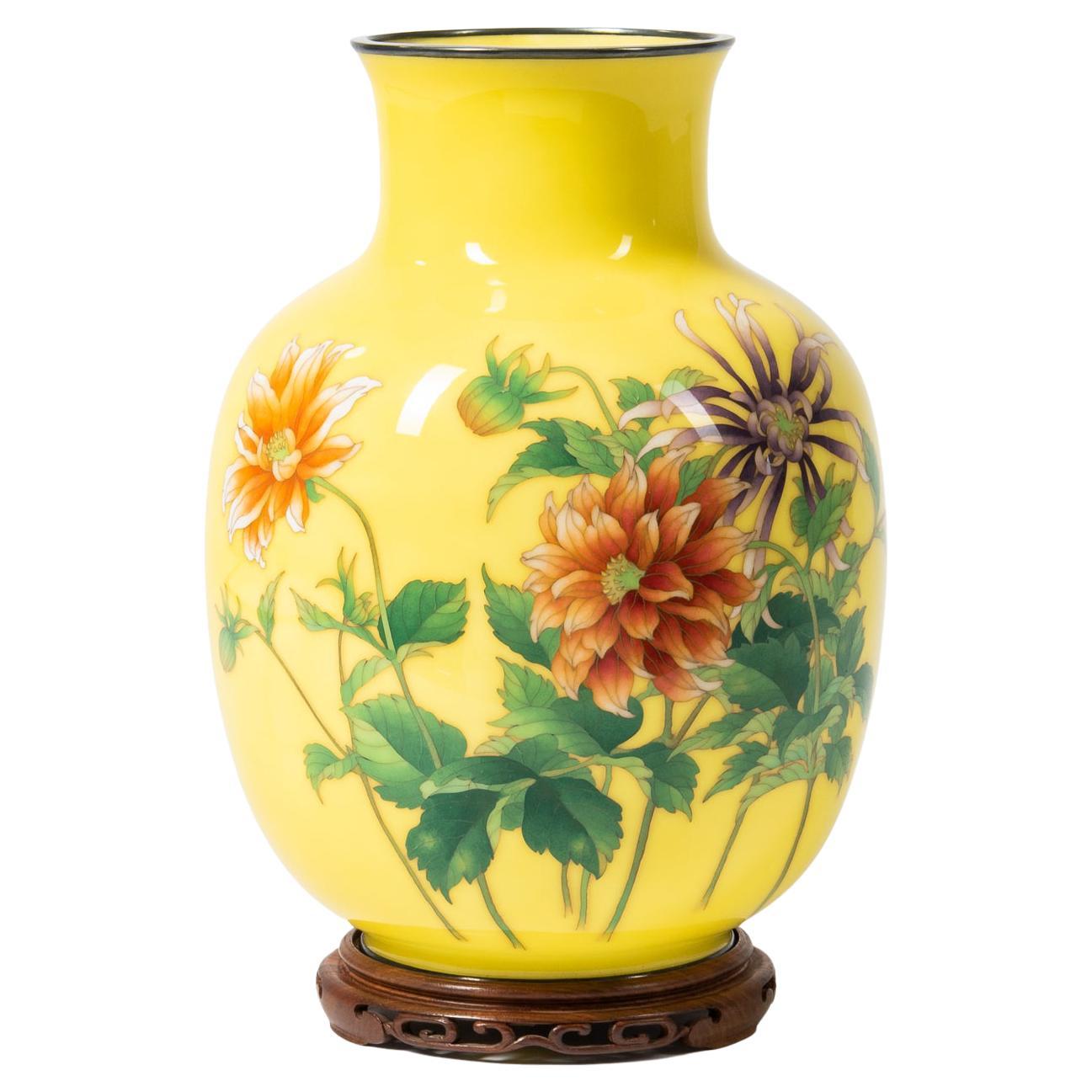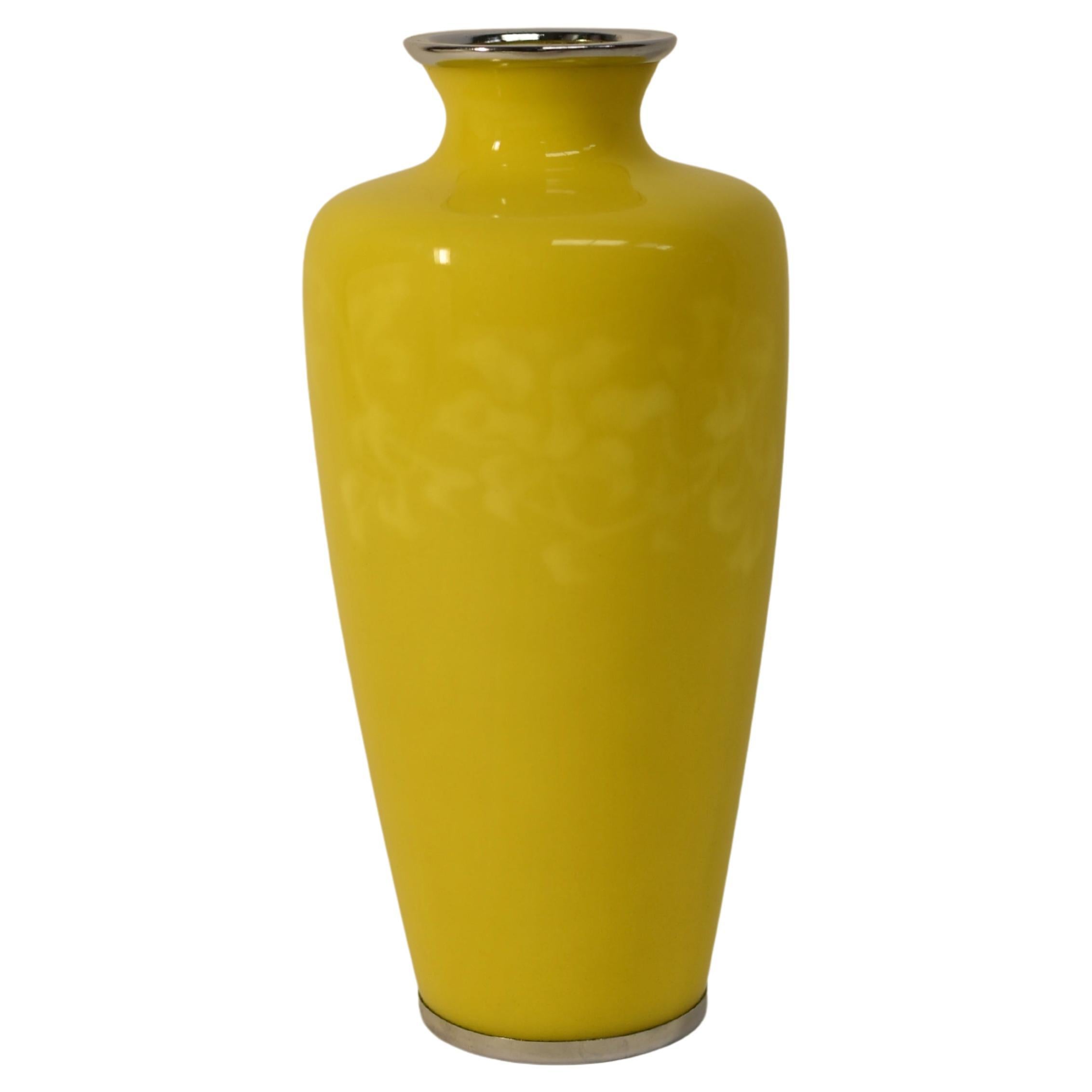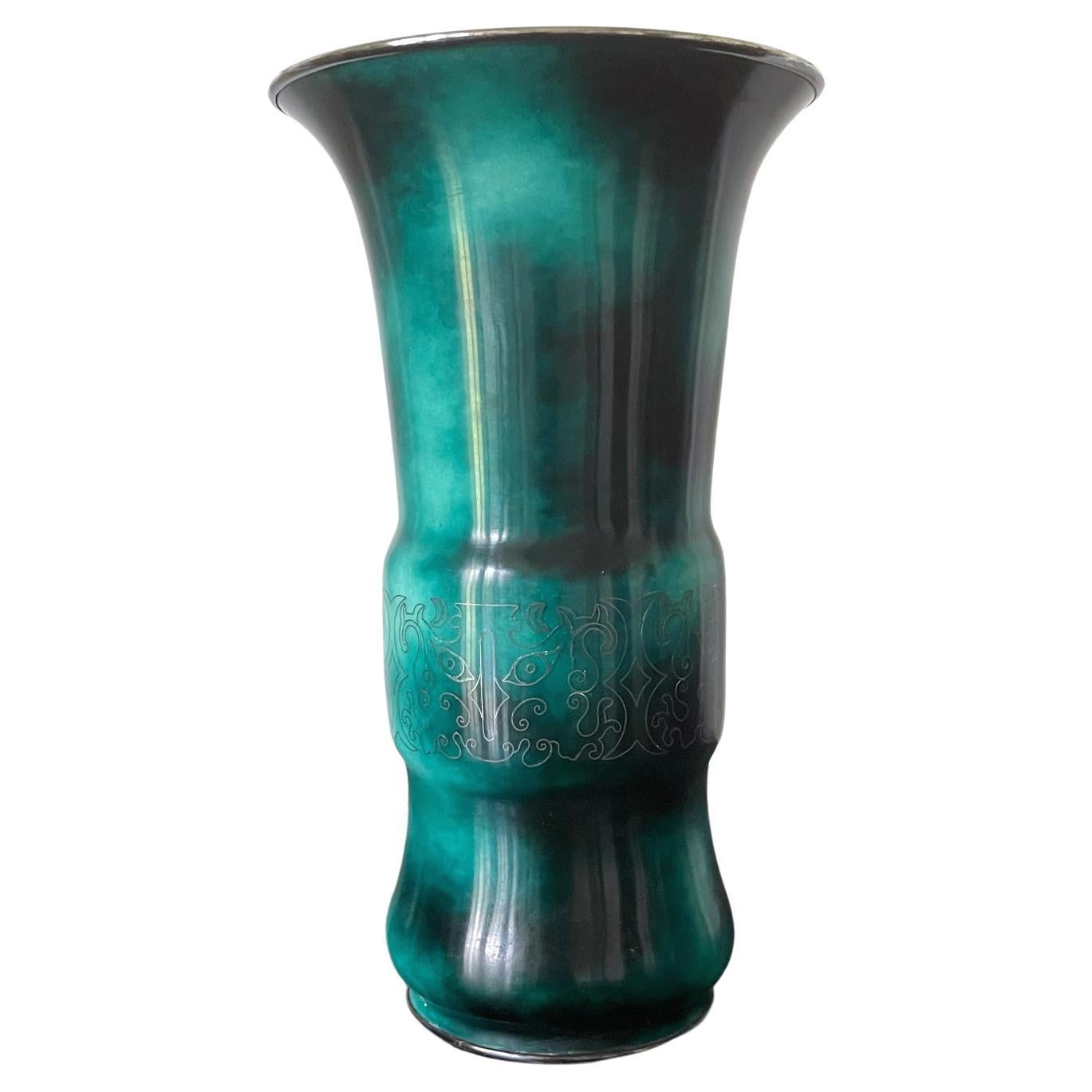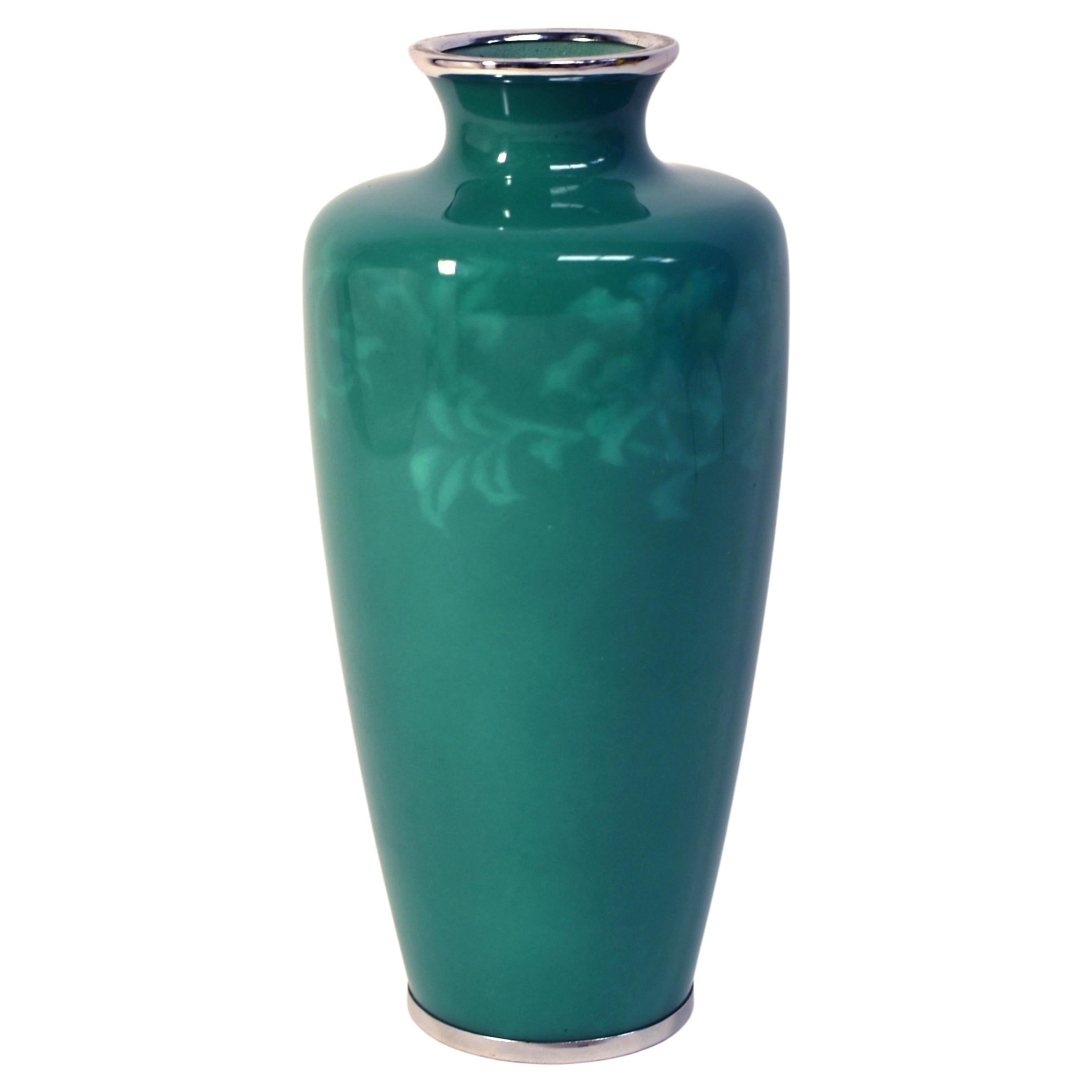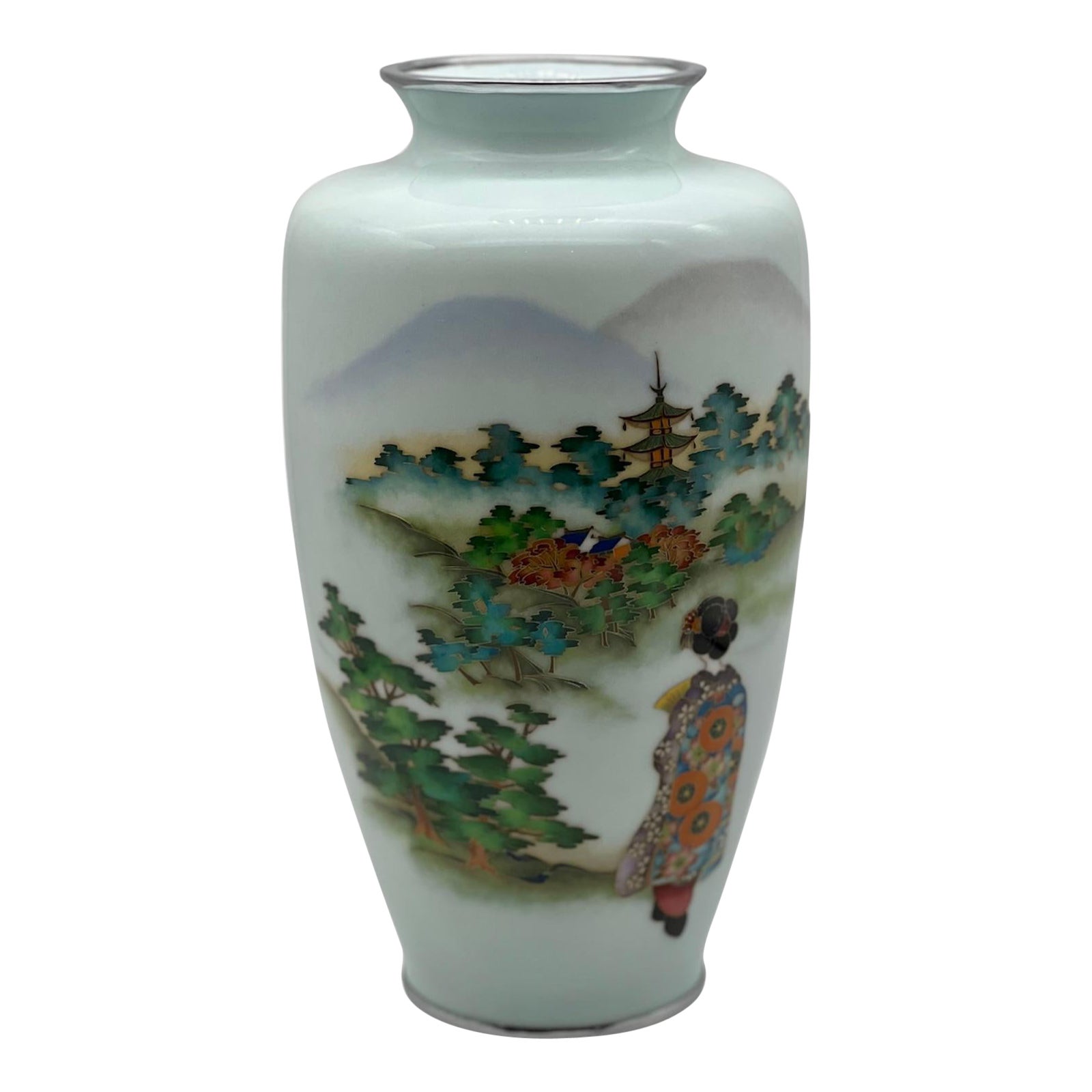Items Similar to Japanese Cloisonné Covered Jar by Ando Jubei
Want more images or videos?
Request additional images or videos from the seller
1 of 11
Japanese Cloisonné Covered Jar by Ando Jubei
About the Item
Japanese cloisonné enamels are known as shippo-yaki and the mid-19th century saw the production of very high quality wares in the early centers Nagoya. One of the most renowned workshops was the Ando Cloisonné Company, founded by Ando Jubei (1876-1953). The cloisonné work from the workshop was considered the finest during the Meiji Period (1868-1912).
This cloisonné covered box is of a very intriguing color, form and design, likely made to use as a tea caddy during Chado ceremony. The surface is of a brilliant and unusual aubergine color. It is sparsely but superbly decorated with a cloud-like abstract pattern by using a network of small individual wire cells filled with multicolored enamels. To create the subtle palette of colors that appears optically drifting, misty, and translucent, great care was taken to control and balance the placement and the application of the wired cells and enamels. The result is a very poetic piece of art work that invites a visual meditation. The jar was fitted with sterling silver lips and foot ring (stamped as pure silver in Kanji) and marked with Ando cipher logo.
Based on the production style, we date the piece to 1910-1920s, the Taisho Period (1912-1926). Purportedly purchased from Christie's in 1980s.
- Creator:Ando Jubei (Maker)
- Dimensions:Height: 5.75 in (14.61 cm)Diameter: 3 in (7.62 cm)
- Style:Japonisme (Of the Period)
- Materials and Techniques:
- Place of Origin:
- Period:
- Date of Manufacture:1910s-1930s
- Condition:Wear consistent with age and use. Very minor wear.
- Seller Location:Atlanta, GA
- Reference Number:1stDibs: LU945013689141
About the Seller
5.0
Platinum Seller
These expertly vetted sellers are 1stDibs' most experienced sellers and are rated highest by our customers.
Established in 2006
1stDibs seller since 2010
481 sales on 1stDibs
Typical response time: <1 hour
- ShippingRetrieving quote...Ships From: Atlanta, GA
- Return PolicyA return for this item may be initiated within 2 days of delivery.
More From This SellerView All
- Japanese Cloisonné Vase Ando Jubei with Storage BoxBy Ando JubeiLocated in Atlanta, GAA beautifully decorated cloisonné vase with silver rims by Ando Jubei (1876-1956), the celebrated Japanese Shippo studio. The piece is dated to late Meiji to early Showa period circa...Category
Early 20th Century Japanese Japonisme Metalwork
MaterialsMetal, Silver, Enamel
- Japanese Wireless Musen Cloisonne Vase by Ando JubeiBy Ando JubeiLocated in Atlanta, GAA Japanese cloisonne vase in bottle-form made by Ando Jubei (1876-1963) circa 1910-20s (late Meiji to Taisho period). The vase features a completely smooth surface without showing an...Category
Early 20th Century Japanese Meiji Metalwork
MaterialsSilver, Enamel
- Japanese Cloisonne Vase with Silver Inlays by Ando JubeiBy Ando JubeiLocated in Atlanta, GAA Japanese cloisonne vase by Ando Company circa 1910-30s, end of Meiji to Tasho period. The vase takes an archaic Chinese bronze vessel form know...Category
Vintage 1920s Japanese Meiji Metalwork
MaterialsMetal, Silver
- Pair of Early Japanese Plique-a-Jour Bowls from NagoyaBy Ando JubeiLocated in Atlanta, GAA pair of small but exquisite Plique-a-jour cloisonné bowls with nearly identical design from Nagoya area in Japan circa 1900-20s. Maker's unknown but possibly by Ando company. The t...Category
Early 20th Century Japanese Japonisme Metalwork
MaterialsMetal, Enamel
- Japanese Table Cabinet with Cloisonne Panels in the style of Namikawa SosukeLocated in Atlanta, GAA Japanese wood and cloisonne cabinet circa Meiji period, late 19th-early 20th century. The small table top cabinet features a single drawer on top, four small doors with cloisonne panels on the second tier, a pair of larger cloisonne doors on the main level flanked by two skinny panels, and finally two drawers on the low level. It has a scroll carved base and sides as well four pagoda-shape cornices. The cloisonne panels were obviously the work of two different artist studios and were assembled on purpose to demonstrate a mixture of styles. The small top and the two skinny panels on the main level are of an earlier scrolling design that emphasize the wire work; The rest of the eight larger panels were done in a much later and painterly style attributed to Namikawa Sosuke...Category
Early 20th Century Japanese Japonisme Furniture
MaterialsEnamel, Metal
- Fine Korean Iron Box with Silver Inlay Joseon DynastyLocated in Atlanta, GAA fine Korean iron box that was traditionally used to store tobacco leaves dated to the late Joseon Dynasty circa 19th century. The box is made from iron and has a heavy weight, although the wears along the edges of the lid and base exposes a bronze metal color underneath, indicating the iron metal may contains a high level of copper. The surface was beautifully decorated with elaborate silver inlay that covers the entire surface except the base. The extraordinary workmanship depicts a pair of deer within the circled square (shape of heaven and earth) and a lined background on the long sides and a crane with spread wings on the shorter sides. Both animals were associated with longevity. Their eyes were highlighted with copper inlay, adding a lively touch to the animation. The lid is centered with a Chinese character "Xi" (Paired-Hui in Korean), which means double happiness. (In Chinese culture, it is often used in a wedding ceremony). The large symbol was set on geometrical background of tightly scrolling diamond pattern surrounded by stylized Ruyi mushroom heads, another floral longevity symbol. Archaic fret cloud band borders the entire perimeters of the lid and the container. Tobacco was introduced to Korean in the first half of the 17th century and gradually gained popularity. When the tobacco was started being smoked in shredded form instead of rolled leaves, there rose the production of the smoking accessories, with some in fine quality as luxury items for the elite. The accoutrement such as this box is a fine example made in late Joseon dynasty, using extensive silver inlay, a technique called "jjoeum-ipsa", in which the silver wires were hammered into the scorched iron surface to create the elaborate design. Similar boxes with variation of shape and motifs are in the collection of several major museums. Compare the box with item Gu 754 in the National Museum of Korea; item 22.78 in MET NYC and M.240:1, 2-1926 in V& A Museum in London. The most closely related example we found is item C232 in the collection of the Museum of East Asian Art...Category
Antique 19th Century Korean Other Metalwork
MaterialsSilver, Copper, Iron
You May Also Like
- Signed Ando Jubei Japanese Yellow Cloisonné VaseBy Ando JubeiLocated in Somis, CABehold the remarkable beauty of a rare Ando Jubei wireless cloisonné vase. This masterpiece, adorned in a extraordinary canary yellow enamel, p...Category
20th Century Japanese Meiji Vases
MaterialsMetal, Enamel
- Signed Ando Jubei Japanese Green Cloisonné Vase ClematisBy Ando JubeiLocated in Somis, CAA masterpiece of Ando Jubei wireless cloisonné vase. In his signature green enamel, portraying an intricate arabesque design of a blooming clem...Category
20th Century Japanese Meiji Vases
MaterialsMetal, Enamel
- A Large Japanese Cloisonne Enamel vase attributed to Ando JubeiBy Ando JubeiLocated in London, GBA Large Japanese Cloisonne Enamel vase attributed to Ando Jubei. Taisho period (1912 – 1926) A large baluster Cloisonne-Enamel vase worked in musen and silver wire of varying gauge...Category
Early 20th Century Japanese Metalwork
MaterialsEnamel
- Japanese Cloisonne Box W Flowers By Ando JubeiLocated in New York, NYA Japanese vintage trinket or jewelry box by Ando in the original box. The round box is decorated on the outside with flowers in purple colors using the cloisonne enamel technique. T...Category
Antique 19th Century Japanese Showa Metalwork
MaterialsBrass, Enamel
- Fine Pair of Antique Japanese Cloisonné Enamel Vase Attributed to Ando JubeiBy Ando JubeiLocated in San Diego, CAFine pair of antique Japanese cloisonné enamel vases dating from the early 1900s. The both are marked by the artist on the bottom. These are attributed to master artist Ando Jubei. B...Category
Early 20th Century Japanese Metalwork
MaterialsEnamel
- Pair Ando Jubei Signed Wireless Cloisonné Vases with RosesBy Ando JubeiLocated in Somis, CAA very rare offering of pair of beautiful Ando Jubei (1876-1956) Rose vases in excellent condition. In classic form with elegant raised shoulders, the master artist employed superb w...Category
20th Century Japanese Vases
MaterialsEnamel, Metal
Recently Viewed
View AllMore Ways To Browse
Japanese Company
Japanese Metal Work
Japanese Clouds
Cloisonne Japanese Cloisonne
Japanes Cloisonne
Japan Cloisonne
Japanese Cloisonne
Antique Japanese Cloisonne Cloisonne
Antique Japanese Cloisonne
Asian Cloisonne
1930s Japan
1930s Japanese
Cover Jar
Covered Jars
Sterling Japan
Metal Cloisonne
Antique Covered Jar
Japanese Meiji Jar
